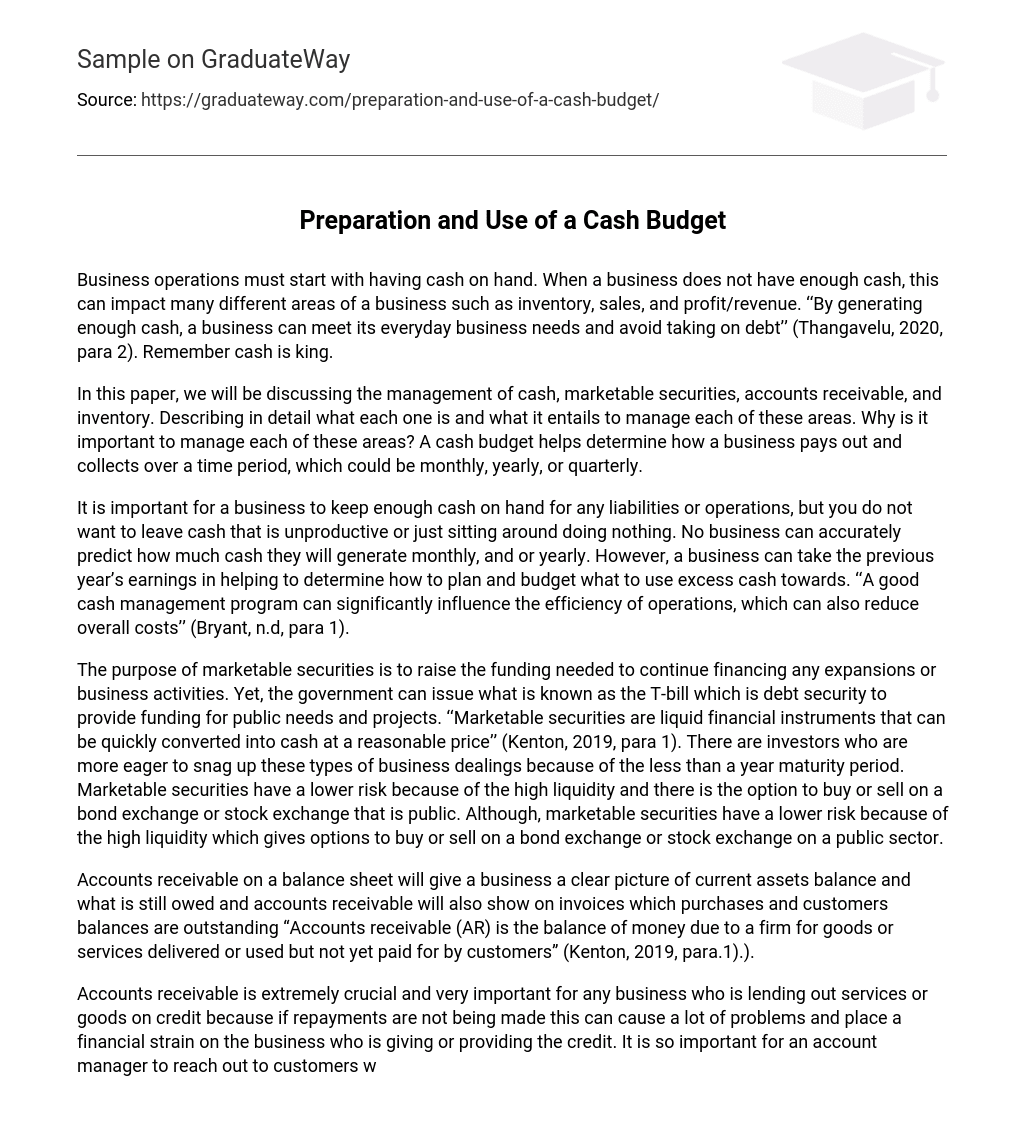Business operations must start with having cash on hand. When a business does not have enough cash, this can impact many different areas of a business such as inventory, sales, and profit/revenue. ‘‘By generating enough cash, a business can meet its everyday business needs and avoid taking on debt’’ (Thangavelu, 2020, para 2). Remember cash is king.
In this paper, we will be discussing the management of cash, marketable securities, accounts receivable, and inventory. Describing in detail what each one is and what it entails to manage each of these areas. Why is it important to manage each of these areas? A cash budget helps determine how a business pays out and collects over a time period, which could be monthly, yearly, or quarterly.
It is important for a business to keep enough cash on hand for any liabilities or operations, but you do not want to leave cash that is unproductive or just sitting around doing nothing. No business can accurately predict how much cash they will generate monthly, and or yearly. However, a business can take the previous year’s earnings in helping to determine how to plan and budget what to use excess cash towards. ‘‘A good cash management program can significantly influence the efficiency of operations, which can also reduce overall costs’’ (Bryant, n.d, para 1).
The purpose of marketable securities is to raise the funding needed to continue financing any expansions or business activities. Yet, the government can issue what is known as the T-bill which is debt security to provide funding for public needs and projects. ‘‘Marketable securities are liquid financial instruments that can be quickly converted into cash at a reasonable price’’ (Kenton, 2019, para 1). There are investors who are more eager to snag up these types of business dealings because of the less than a year maturity period. Marketable securities have a lower risk because of the high liquidity and there is the option to buy or sell on a bond exchange or stock exchange that is public. Although, marketable securities have a lower risk because of the high liquidity which gives options to buy or sell on a bond exchange or stock exchange on a public sector.
Accounts receivable on a balance sheet will give a business a clear picture of current assets balance and what is still owed and accounts receivable will also show on invoices which purchases and customers balances are outstanding “Accounts receivable (AR) is the balance of money due to a firm for goods or services delivered or used but not yet paid for by customers” (Kenton, 2019, para.1).).
Accounts receivable is extremely crucial and very important for any business who is lending out services or goods on credit because if repayments are not being made this can cause a lot of problems and place a financial strain on the business who is giving or providing the credit. It is so important for an account manager to reach out to customers who may not be paying on their accounts and try to work with them before taken legal action necessary to get the money owed to them.
“Inventory management refers to the process of ordering, storing, and using a company’s inventory. These include the management of raw materials, components, and finished products, as well as warehousing and processing such items’’ (Hayes, 2019, para 1). Inventory management also includes overseeing and controlling purchases made, maintaining stock, order fulfillment, and having the control of product for sale. Yet, some businesses may use inventory software but not all software provides complete accuracies so at times a hand count may be necessary. Although, there are four categories to inventory such as raw materials, work in progress, finished goods, maintenance, repairs, and operations. It is vital for any business in having inventory management in place that will track inventory coming in and inventory going out. ‘‘Depending on the type of business or product being analyzed, a company will use various inventory management methods’’ (Hayes, 2019, para 11).
In conclusion, current assets management focuses mainly on the current assets of a business. However, cash flow, marketable securities, accounts receivable, and inventory all play a major within the business and all must work together, and all considered part of a business current assets. Current asset management’s main goal is to keep the liabilities and income flow balanced which can help in any long-term investment decisions.
A business must know what the liquidity is and how fast it takes for a business to pay off any debts acquired. Asset management helps managers stay on track and find problems as quickly as possible so that they can be addressed. Without asset management in place at any business things could quickly go wrong that can result in having to file for bankruptcy, legal issues, and even having to close shop for good.





